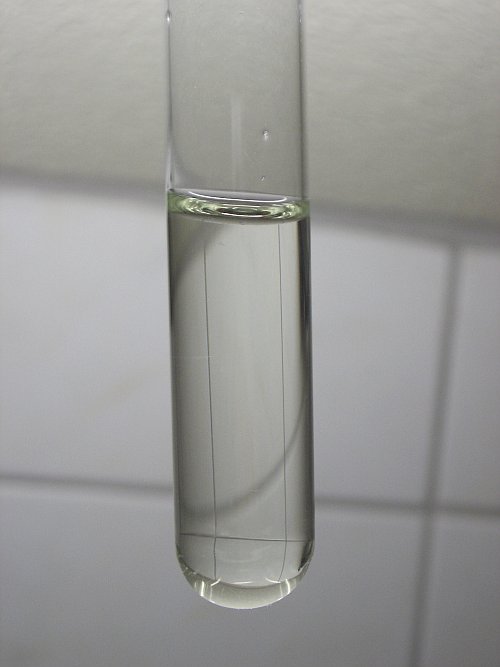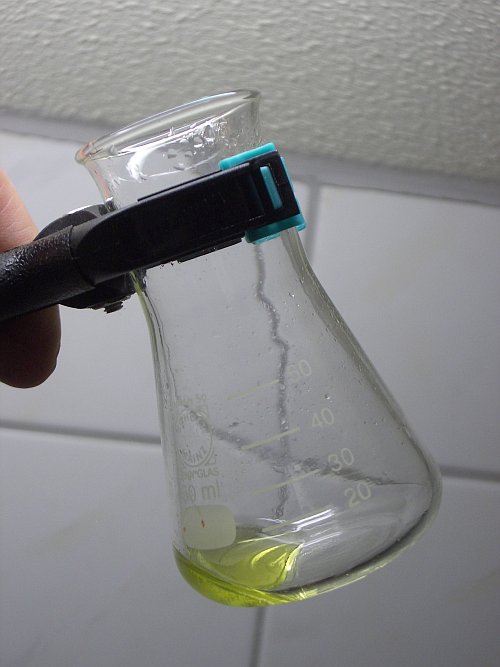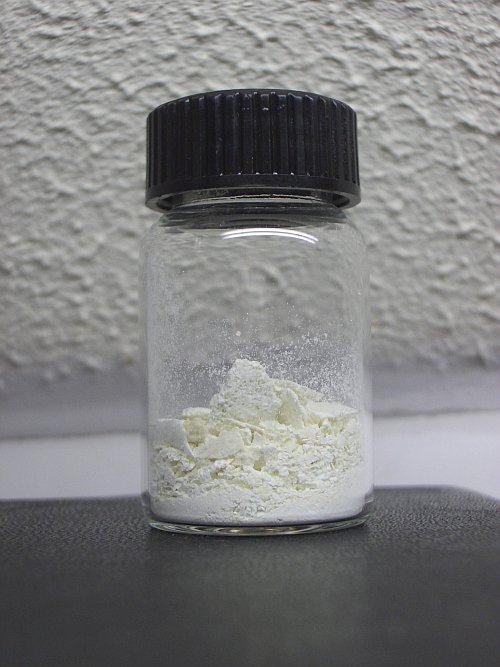


Chemistry of praseodymium
Praseodymium is a very reactive metal, which reacts with water. It does not react as vigorous as calcium metal, but still, when left in contact with water for a somewhat longer time, it will be converted to hydroxide completely.
Praseodymium only exists in the +3 oxidation state in aqueous solution and then its color is pale green. In concentrated hydrochloric acid, however, its color becomes much more intense and shifts towards yellow.
Here, multiple experiments are presented with praseodymium metal and also with praseodymium chloride. If one wants to repeat this experiment and only one of the chemicals is available, then also part of the experiments can be done.
![]()
![]() Required
chemicals:
Required
chemicals:
-
praseodymium
-
praseodymium chloride
-
hydrochloric acid
![]() Required
equipment:
Required
equipment:
-
test tubes
- glass beaker or erlenmeyer; a simple glass bottle also is suitable
![]() Safety:
Safety:
- Hydrochloric acid is corrosive and the concentrated acid gives off pungent fumes, which should not be inhaled.
- The reaction with concentrated acid is quite vigorous and quite some heat is produced. Be prepared for the possible event that the contents of the test tube foams over its rim.
![]() Disposal:
Disposal:
- Although praseodymium is not considered very toxic, it is best to keep the waste and bring this to a proper waste processing facility.
![]()
Reaction of praseodymium with water
Take a piece of praseodymium metal with the size of a pea and put this in a test tube with some water. Watch what happens.
Initially it looks as if no reaction occurs. After a few seconds, tiny bubbles of gas can be observed on the piece of praseodymium. After a few minutes, the bubbles are larger. The bubbles of gas are hydrogen. The color of the piece also changes. It becomes lighter, due to formation of very pale green praseodymium hydroxide.



As this experiment shows, praseodymium metal reacts with water, but the reaction is not fast. However, when the metal is kept under water for a prolonged time, then all of it will be converted to the hydroxide.
![]()
Reaction of praseodymium with dilute hydrochloric acid
When praseodymium metal is added to dilute hydrochloric acid (appr. 10% HCl by weight), then it dissolves while bubbling vigorously, but not violently. A noticeable amount of heat is produced, but the liquid does not become hot. The two pictures below show the reaction of a small piece of metal.


While the metal dissolves, the liquid remains colorless. Only when a lot of metal is dissolved in dilute hydrochloric acid, a noticeable green color can be observed. The intensity of the green color of aqueous Pr3+ ions is low. The picture below shows a solution with more than 10% by weight of praseodymium metal, which is very concentrated.

![]()
Praseodymium and concentrated hydrochloric acid
When praseodymium metal is added to concentrated hydrochloric acid (appr. 30% HCl by weight), then it dissolves while bubbling violently. A lot of heat is produced and the color of the liquid becomes deep yellow.
Below follows a series of pictures, made by adding a piece of metal to a few ml of hydrochloric acid. First, a green foam is produced. When more and more praseodymium metal is dissolved, then the color deepens. At a certain point, as the rightmost picture shows, the color is deep yellow, just before the vigurous foaming ceases.



There also is some dark grey/black gunk at the top of the foaming liquid. When the foaming stops, this stuff sticks to the glass. This is nicely shown by the final picture. This material is due to impurities in the praseodymium metal. During the foaming, a lot of hydrogen gas is produced, but a noticeable amount of phosphine is produced as well, due to phosphorous impurities in the metal sample.
After a while, the foaming completely ceases and then a yellow liquid remains. On much longer standing, this liquid becomes light green and turbid. Probably this is due to continued dissolving of the metal in the non-acidic solution (all acid is used up). The picture below shows what remains after a longer time. A lot of insoluble matter is present, the remains of the piece of metal can still be seen and the liquid has become light green.

![]()
Preparation of the solid salt PrCl3
When some metal is dissolved in dilute hydrochloric acid and the grey insoluble gunk is filtered out of the clear solution, then it is easy to prepare the solid salt PrCl3.
Below, it is explained how the praseodymium chloride is prepared. Approximately 2 grams of metal are dissolved in dilute hydrochloric acid (as shown above). The grey gunk is filtered from the solution and the clear light green liquid is put in an erlenmeyer. Then the liquid is boiled and concentrated. While the liquid becomes more concentrated, it first becomes slightly more green. But at a certain point, where the liquid is very concentrated, the color quickly shifts towards a deep yellow with a greenish hue. The picture below at the left shows the very concentrated liquid.


This color is very much like the color of the solution, produced when the metal is dissolved in concentrated hydrochloric acid, as is shown further above.
When this yellow liquid is heated to dryness, then at first a light green amorphous compound is formed. On further heating, it becomes brown. But if the heating is done carefully, then a nice dry light green solid can be obtained without the brown material. The brown material may be some oxy-chloride compound or a basic praseodymium salt, but it is not the desired product. The final product is shown in the picture at the right.
Below, some experiments with the prepared PrCl3 are described.
![]()
Dissolving of PrCl3 in water and hydrochloric acid
When solid PrCl3 is added to distilled water, then it dissolves almost at once. The solid piece has disappeared within a few seconds. The liquid, however, is not clear, it remains fairly turbid, although there certainly is not a heavy precipitate. The result is shown in the left picture below. When a few drops of dilute hydrochloric acid are added to this cloudy liquid, then the liquid becomes totally clear and very light green. With just a spatula full of PrCl3, the green color cannot be observed at all and the liquid looks colorless.


When a piece of solid PrCl3, as prepared according to the procedure, described above, is added to concentrated hydrochloric acid, then the solid only slowly dissolves. It takes several minutes of shaking before all of the solid has dissolved. However, the intensity of the color is much higher than one would expect on the basis of the amount added. The color also is much more yellow than one would expect. Apparently, praseodymium (III) ions form a complex with chloride in highly concentrated solutions of chlorides.
In both experiments with water and with concentrated HCl approximately the same amount of PrCl3 was taken in the same amount of liquid. In the first case, the dissolving only takes a few seconds, but the liquid remains cloudy and even on dilution it remains cloudy, as shown by the left picture above.
![]()
Praseodymium in low boiling point ligroin
When a piece of metallic praseodymium is added to some low-boiling ligroin (boiling range 40 - 60 °C), then the metal quickly is covered by some white/grey layer. It is a mystery to me, what causes the formation of this layer. It may be due to the presence of oxygen in the ligroin, which reacts with the metal, but this only is speculation. The reason for adding this here, it that it was discovered by accident and the result is quite surprising. Below follows a picture of a piece of praseodymium metal, added to ligroin.

![]()
Discussion of results
![]() Praseodymium metal slowly reacts with water as
follows:
Praseodymium metal slowly reacts with water as
follows:
2Pr + 6H2O → 2Pr(OH)3 + 3H2
This reaction is slow and it takes hours before an appreciable amount of hydrogen gas is produced. The Pr(OH)3 is insoluble in water and forms a light layer on the praseodymium metal.
![]() With acid, the reaction proceeds much faster:
With acid, the reaction proceeds much faster:
2Pr + 6H+ → 2Pr3+ + 3H2
![]() With chloride at high concentration, a complex is
formed. This most likely is an anionic species, PrCl3+nn–.
With chloride at high concentration, a complex is
formed. This most likely is an anionic species, PrCl3+nn–.